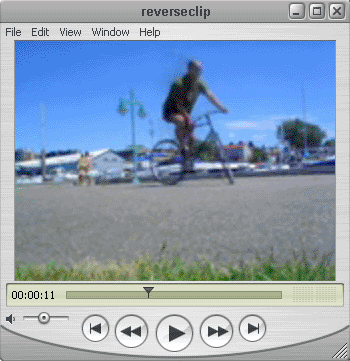[ 63XC.COM | HOW TO | REVERSING ]
Reversing Part 2
[ PLAY CLIP (QUICKTIME, 700K) ]It's been a year since Reversing. What's been happening? I've been working on the second of a series of movies about fixed gear riding. I've chosen to ride fixed (both forwards and backwards) for the vast majority of my riding. In fact, I've done more fixed gear trail riding this past year than during the whole of the two years prior. It got me out of the doldrums. Fixed gear is a well-documented tonic for bike burnout. Reversing takes it a little further. It adds an element of offbeat pseudo-impracticality that can go a long way to renewing your enthusiasm. In the hopes of capturing your attention and imagination, I've been working up a set of rationales for slowing down, stopping, and trying to back up. Here's my top ten: 1. Reverse is a bit of bicycle "freestyle" that even a fortysomething can learn. Caution: you will fall down while learning, and likely occasionally even after you learn. Are you still doubting the sense of this craziness? Sure, it's partly entertainment for yourself and your friends and especially people in cars. And I'll admit you won't use it much. But learning to back up will bring real improvements to your balance and feel on the bike, and your trackstand balance will become a sixth sense. (If you really want to know where your balance is at, try trackstands with your eyes focused above the horizon... and, for extreme training, try it with your eyes closed.) In part one, I focused on getting your basic skills together. This means learning to trackstand reliably and mastering the hi-low or 6pm/12pm pedal position where one often loses control and balance. There's still time to review... Building on those chops over the last year has further honed my reversing skills. I can now do three-point turns on all kinds of trail surfaces. I can even ride straight backwards, finally. Once or twice I've even managed to reverse up a curb! Here are some advanced tips based on that experience. 2. Practice trackstands, especially on your weak side. Practice both standing and sitting. My raw polling indicates a lot of variation amongst riders about this. I find both comfortable, but sitting is sustainable for longer periods. Missing my #1 tip? Here it is, and it's good for all back-ups, basic or advanced. Ready? Success is a matter of getting from one control position to the next. Half-pedal strokes are all it takes. Think about getting from one (3-9 o'clock) position to the next. Once you can to go a half-rotation backwards to a controlled trackstand, you'll know that you've got it. Over and Out.
[ TOP ] |
Writer
John 'Gonterian' Gonter resides in Burlington, Vermont where there are more fixed gear commuter bikes than anywhere he's ever seen. He has his own blog.
Date
v1.0 written August 2006
Related
John's original piece on riding backwards is here (no slacking) and his movie trailer is here.
Mailing list
Join the 63xc.com list.
